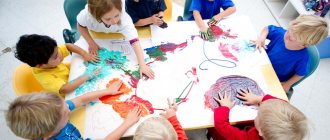Progress of the game:
An adult begins a fairy tale:
“There is a little mansion in the field,
He is not short, not high, not tall.
Is there someone running across the field towards the house?
Here across the field, is someone in a hurry to the house?”
Children listen to music and determine which fairy tale character by the sound.
she comes up. A child who correctly guessed whose music is playing ,
goes out to the playing field and inserts the corresponding figure of the fairy tale hero into the slot in front of the house.
2. Development of dynamic hearing
2.1. "Silent and loud bells"
Goal: to develop dynamic hearing.
Game material: rattles or noise toys according to the number of children.
Didactic game "Quiet-loud"
The purpose of the lesson is to teach the ability to change the volume of the voice, to reinforce the correct pronunciation of sounds.
Children of the younger group of kindergarten are playing. The teacher needs to prepare different-sized pairs of toys: large and small - drums, rattles, cars, bells.
The teacher takes a couple of objects and explains to the students: “The big car beeps loudly, “Beep-Beep,” and the small one, quietly, “Beep-Beep.” Participants repeat the sounds of cars after the teacher. Next, the teacher, having hidden the cars, gives the task: “When you see a big car, beep loudly, when you see a small car, beep loudly.”
When children see the toy and begin to make a sound, make sure that their voice does not turn into a whisper.
Classes with other toys are carried out in a similar way.
Game "Silence and Noise"
You can play both in kindergarten and at home. The lesson is designed to correct behavior. It helps to make the child organized, disciplined, and also develops auditory perception and concentration.
When the parent speaks quietly, the baby should tiptoe without making noise. And when it’s loud, you can make noise, rush around, shout. It is important to explain that you need to focus your actions not on words, but on the power of your voice. If the parent orders to make noise, but speaks quietly, then the baby should behave calmly.
Increase the difficulty gradually. Give volume-appropriate instructions first. For example: “Walk on tiptoe” in a quiet voice or “Jump” in a loud voice. Next, complicate the lesson, give tasks that do not match the volume. For example: “Clap your hands” quietly or “Walk on tiptoe” loudly. To make the game even more challenging, start changing tasks and volume suddenly.
Game "Bells"
Kindergarteners of the middle group are playing. For the lesson you need to prepare a box with rattles.
The purpose of the musical-didactic game “Quiet and Loud Bells” is to develop musical hearing and perception of sounds of different heights.
Tasks:
- learning the ability to distinguish between soft and loud sounding music;
- learning the skill of playing musical instruments quietly and loudly;
- development of concentration;
- nurturing interest in music and musical instruments;
- training in teamwork skills.
Pupils examine rattles. The rule of the musical-didactic game “Loud-quiet”: when the teacher plays music quietly, the children should play the same way. When the teacher starts playing loudly, then the children should rattle the rattles louder.
The teacher begins to play music, the students rattle their toys to the beat in accordance with the strength of the sound. Then the teacher complicates the task: he begins to sing, and the participants, based on the strength of his voice, must determine how to shake the rattles.
Didactic games for musical development at a young age
Teacher (seats the children on chairs and sits opposite them). Let's play today as if we are the owners and are waiting for guests who will show us something fun, funny and interesting. Today two Parsleys, two dolls and two bunnies will come to us. You will all take turns being guests first and then hosts.The teacher shows the children the prepared attributes: caps for Parsley, ears for bunnies, skirts for dolls.
– Parsleys will run and make children laugh, dolls will dance, and bunnies will jump. Guests will come in turn, and the owners need to guess who is going to come and call him. Now listen and remember how the hosts will find out which guest is about to appear. If you hear such a beautiful, drawn-out sound (duit), know that Parsley will appear now. What kind of sound is it, drawn-out or intermittent? (Children's answers.) If you hear music like this (melody on a metallophone), it means the dolls are coming to us. They will dance to this music. What kind of sounds are these, drawn-out or, like a drum, abrupt? (Children's answers.) Well, if such a sound (tambourine) sounds, it means that bunnies have jumped up to us. They love to jump to such abrupt sounds. (Repeats the signals.) As soon as the signal sounds, everyone needs to unanimously call the guests and invite them to enter. If you solve the riddle, the guests will come in and show you what they can do. We will unanimously applaud them and invite them to sit down. The hosts will greet all guests in turn.
The teacher needs to choose two children to play the role of each guest and help them put on the appropriate attributes. He reminds the children that they can all be guests. Guests go into the adjacent room so that through the slightly open door they can hear and see what is happening in the group. The most important thing is that they hear the signals.
The teacher approaches the table with toys, blocks them with a screen so that they are not visible to either the guests or the owners, and gives the first signal. He invites the hosts to name the guests and invite them. Having heard the invitation, the guests come, bow and perform their number. Next, a signal is given for the next pair of guests, and the hosts greet them. The game continues until all children have played guests.
According to the rules of the game, the hosts must guess which of the guests is coming, greet them politely and applaud them after the performance. Only those children who were hospitable hosts are chosen to play the role of guests. Each guest can come up with what to show the hosts, but he must agree on this in advance with the teacher. The best guest is the one who came up with something unusual and did not break the rules of the game.
1. “Wonderful bag”
Game material: A small bag, beautifully decorated with applique. It contains toys: a bear, a hare, a bird, a cat, a cockerel. You can use characters from the puppet theater.
Progress of the game: The whole group participates. “Children,” says the teacher, “guests came to our lesson. But where did they hide? Maybe here? (Shows the bag) Now we’ll listen to the music and find out who’s there.” The music director plays melodies of works familiar to the children: “Cockerel” - a Russian folk melody, “Grey Cat” by V. Vitlin, “Sparrows” by M. Krasev, “Bear” by V. Rebikov, etc. Children recognize the music, one of them gets from the bag the corresponding toy and shows it to everyone.
2. “Think and guess”
Game material: Cards (according to the number of players), which depict: a bear, a bunny, a bird.
How to play: Children are given one card each. The following melody sounds on the piano or in a recording: “Bunny” by M. Starokadomsky, “Bear” by V. Rebikov, “Sparrows” by M. Krasev. Children recognize the melody and pick up the correct card. For example, after the song “Bears” by V. Rebikov, they raise a card with a picture of a bear.
3. “Birds and Chicks”
Game material: A ladder of three steps, a metallophone, toys (3-4 large birds, 3-4 chicks).
Progress of the game: A subgroup of children participates. Each child has one toy. The teacher plays low and high sounds on the metallophone, for example, up to the second octave. Children holding chicks must go out and place the toys on the top step. Then it sounds up to the first octave, children place large birds on the bottom step.
4. «Hen and Chicks"
Game material: House, Masha doll, metallophone. Everything is laid out on the table. Children hold toy birds (chicken and chicks) in their hands.
Progress of the game : Children sit around the table. The teacher takes the doll and says:
“The doll Masha lives in this house; she has a lot of hens and chicks. It's time to feed them, but they ran away. Masha, call your chickens. Listen, guys, who is Masha calling,” plays the D of the second octave on the metallophone. Children place chicken figures on the table in front of Masha and sing “ko-ko-ko” using the same sound.
5. "Guess"
Game material: 4-6 large cards - each divided into two parts. The first half depicts a goose, the second - a gosling (duck-duckling, cat-kitten, cow-calf, etc.)
Progress of the game: The game is played with a subgroup of children (4-6) at the table. Each player has one card and two chips. The teacher says: “Ga-ga-ha” (sings on D of the first octave), the children cover the picture with a gosling with a chip.
6. "In the Forest"
Game material: The tablet shows a forest; 2-3 trees, a stump, are glued to the picture with its middle part in height. This, as it were, creates volume and, in addition, a pocket is glued to one half of the tree (Tree, hemp), in which a figurine of a girl is placed and placed next to the forest.
Progress of the game : “Children, look. “What a beautiful forest,” says the teacher. - There are birches and fir trees here. The girl Tanya came to the forest to pick flowers and berries. And someone was hiding behind a tree, probably some kind of animal. Let's help Tanya guess who is sitting there. Listen to the song and guess." For example, “Zainka,” a Russian folk melody arranged by N. Rimsky-Korsakov, is performed on the piano or on a recording. To check the answer, the child is allowed to look behind the tree where the bunny figurine is located (the picture of the Christmas tree is bent along the center, there is a pocket there). Ira is carried out with all children and can be used in a music lesson while singing and listening to music.
7. “They brought us toys”
Game material: Musical toys: pipe, bell, musical hammer; cat (soft toy); box.
Progress of the game. The teacher takes a box tied with a ribbon, takes out a cat from there and sings the song “Grey Kitty” by V. Vitlin. Then he says that in the box there are also musical toys that the cat will give to the children if they recognize them by their sound. The teacher plays musical toys unnoticed by the children (behind a small screen). Children recognize them. The cat passes the toy to another child. The same pipe is not transmitted; it is advisable to have several of them.
The game can be played at a festive matinee or during leisure hours.
8. "Caps"
Game material: Three colorful paper caps, children's musical instruments: harmonica, metallophone, balalaika.
Progress of the game: A subgroup of children sits in a semicircle, in front of them is a table, on it there are musical instruments under caps. The teacher calls the child to the table and invites him to turn his back and guess what he will play on. To check the answer, you are allowed to look under the cap. The game is played during free time from classes.
9. “Our Orchestra”
Playing material: Children's musical toys and instruments (domras, balalaikas, pipes, bells, tambourines, squares), large box. Progress of the game: The teacher tells the children that a package has arrived at the kindergarten, shows it, takes out musical instruments and distributes them to the children (preliminary acquaintance with each instrument is carried out during a music lesson). Everyone plays these instruments the way they want.
This game situation can be used at a matinee. After the children’s “creative” play, the teacher offers to listen to the senior group’s orchestra play.
10. “What are the children doing?”
Game material: Cards (according to the number of players), on one half of which children are depicted (they sing, march, sleep), the second half is empty; chips. How to play: Children are given one card each. The teacher performs familiar musical works (can be recorded) “Lullaby” by A. Grechaninov, “Bay-bye” by V. Vitlin, “March” by E. Parlov, any song (which children know and sing). The one who recognizes the piece of music covers the empty half of the card with a chip.
The game is first played during class and then in free time outside of class.
Techniques for conducting musical and didactic games with children aged 1.5–4 years
As in working with any other material, the teacher uses 3 groups of techniques to conduct musical and didactic games.
Verbal techniques
The formation of speech skills at 1.5–4 years is a priority area for the development of children. If in the first younger group children are just beginning to express themselves in individual words and simple sentences, then in the second group their skills are significantly enriched, the children are actively mastering the grammatical structure of speech. When working with one or another age category of pupils, it is important to provide children with the opportunity to hear spoken speech in order to form their own speech image.
This is interesting. Games with music allow you to enrich the timbre and dynamic characteristics of children's speech.
Explanation, conversation
These techniques are used on two levels: firstly, to introduce the characters of the game, and secondly, to clarify the game rules. In addition, the teacher talks about the music that accompanies the game. In this case, the story is built on the basis of a conversation: the teacher indicates the name of the work, and then asks the children questions of a reproductive nature regarding the tempo and mood of the melody (“Is this music fast or slow?”, “Is the melody sad or happy?”).
The explanation can be carried out on behalf of the game character, that is, a toy
Riddles and poems
Any type of activity requires motivation of kids. Especially if we are talking about younger preschoolers who do not yet have the ability to concentrate their attention at the request of the teacher. One of the best ways to motivate children to work and not drag out this process for a long time is riddles and poems. Since the plots of most games are related to animals, the material is selected according to the topic.
So, before playing the game “Who Lives in the House,” in which each resident of the house corresponds to one or another instrument, I offer my students the following riddles about the heroes of the game:
- He slept for a long time all winter, sucked his right paw, and woke up and began to roar. This forest animal... (Bear).
- What is before us? A miracle with long ears, he jumps and hops along the path, like a soft ball. Who is this? Guess it! Well, of course, this is... (Bunny).
- An important gait, a red beard, spurs, a scarlet comb, This is Petya... (Cockerel).
This is interesting. When working with younger preschoolers, it is better to select riddles with agreements, so that it is easier for children to navigate when choosing an answer according to the rhyme.
Poems are also selected according to the plot; they should not be too long, otherwise the children will become distracted and it will be difficult to get them to work.
In my personal practice, I introduced poems before games that involved musical instruments. Children especially like rhymes with imitation sounds:
- Drumming the drum, Bam-bam-bam and bam-bam-bam. Very loud, I know it myself, Bam-bam-bam and bam-bam-bam, The drum is drumming, Bam-bam-bam and bam-bam-bam.
- Doo-doo, doo-doo-doo, I blow my trumpet. I can be a trumpeter, doo-doo, doo-doo-doo.
- Three strings in total, shake and shake. The tool is known to us. I'll take the balalaika and start the dancing one.
- Damn it, I took the guitar, I didn’t know how to play it. Let dad teach me - I will be the best guitarist.
Poems with imitation sounds help children remember the sounds of instruments
Short stories
Stories and stories on the theme of the game perfectly illustrate the game. In my practice, I use such fairy tales, invented on the fly, to unite the heroes of the game with those game actions that are assumed by the conditions. For example, for the game “Forest Orchestra,” in which kids identify an animal by the sound of a musical instrument, the story could be like this: “Once upon a time there was a Bunny. He really liked the way the birds sing, but when he tried to repeat their melodies, he got some strange sounds. And then the wise Owl advised Bunny to go to the market and buy a pipe. So he did. I began to play, and the forest animals also wanted to learn to play musical instruments. The Bear went to the market and bought a drum, the Wolf took a tambourine the next day, and the Fox learned to play the piano. And it turned out to be a real forest orchestra.”
Read also: Reading fiction with children in the preparatory group of kindergarten
Visual techniques
As already noted, visibility is an indispensable attribute of any type of activity for preschoolers.
Printed materials and pictures
For musical educational games this is:
- images of musical instruments,
- booklets (folding books containing pictures of game characters),
- drawings or coloring pages based on game plots,
- puzzles, lotto with images of musical instruments.
Lapbooks
For children of the second youngest group, who already have some ideas about music, a current visual device is a lapbook - a homemade folder with materials for games on a specific topic, for example, “New Year holidays”, “Spring has come”, etc. Children consider such materials , discuss with the teacher.
A lapbook can store materials for some musical and educational games.
Demonstration
An approach that involves:
- watching a video showing game actions,
- demonstration by the teacher of all game movements (especially if these are outdoor games),
- showing presentations about musical instruments.
This is interesting. Children of primary preschool age are characterized by imitation in movements, so you can demonstrate play actions on behalf of children’s favorite toys, for example, glove puppets.
Interactive musical and didactic games
One of the most popular demonstration techniques is interactive musical and didactic games: an animated video reveals the essence of game actions and leads to the essence of the task.
Kids enjoy watching games on the multimedia screen, quickly getting involved in game actions
Video: musical and didactic game “Sun”
Props
Of course, when conducting musical and didactic games for playing music, you cannot do without instruments. Kids should have an idea of the visual image of the instrument that is mentioned in the game. The availability of tools is determined by the material and technical base of the preschool educational institution, but, as a rule, kindergartens have:
- piano,
- drum,
- tambourine,
- pipe,
- guitar,
- xylophone.
These instruments allow children to gain an understanding of the variety of musical sounds. Attributes for games are part of the musical corner of the subject-development environment in the group.
This is interesting. The music area should also feature portraits of composers whose works children listen to in class (Tchaikovsky, Kabalevsky, Mozart, etc.).
The music corner introduces children to a variety of instruments for playing music.
Practical techniques
Usually these techniques are used as a kind of reflection after the game: children draw characters, make applications, and crafts on the topic. In the first junior group, this work is reproductive in nature: the children repeat what the teacher demonstrates (glue, paint, sculpt). In the second younger group, pupils show more creative independence: they no longer just paint, but draw, not only glue appliqué elements, but also place them on the base themselves, etc.
In my work in the second junior group, I invite children to create projects together with their parents that introduce musical instruments. Students choose any instrument, draw it or paste a photo, select riddles, poems, fairy tales about it, and also find interesting facts from history.
Making musical instruments by children together with their parents is a very interesting practical technique.




